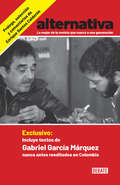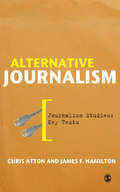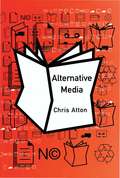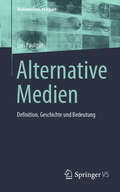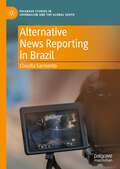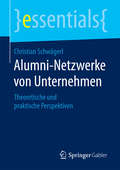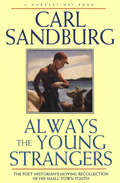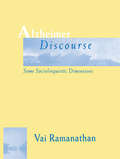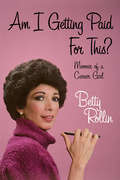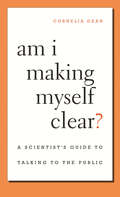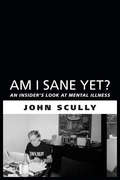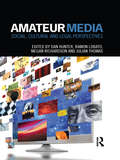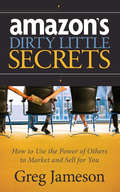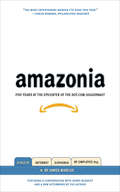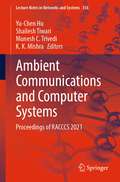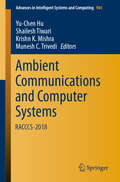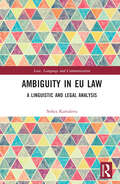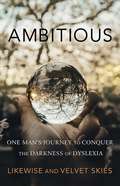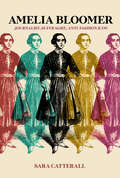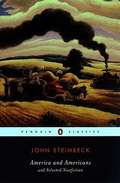- Table View
- List View
Altared: A Tale of Renovating a Medieval Church in Tuscany
by Kyle Tackwell BallWhen Kyle Tackwell Ball’s search for a quaint country home near Florence, Italy, in move-in condition somehow led to the purchase of an abandoned church in a small borgo near Greve-in-Chianti called Le Convertoie, she ended up with much more than a project to overcome her newly contracted “empty nest syndrome.”Ball soon found herself starring in a “Stones and Bones Classic”; the ruin she’d purchased would require years of renovation and an endless amount of money before it would become habitable. But her journey had unexpected rewards, too: she reconnected with some wonderful friends, made new ones, learned the language of her newly adopted home country, and became experienced in the Italian knack of getting around the system. Most importantly, she learned to appreciate Italian culture, food and wine, and how rewarding it is to give new life to a beautiful old building. Ball’s renovation was featured in the March 2010 “Before & After” issue of Architectural Digest, beautifully documented by Kim Sargent of Sargent Architectural Photography.
Alternativa
by Varios AutoresEnrique Santos Calderón selecciona los mejores artículos, reportajes, caricaturas, portadas, editoriales, columnas y entrevistas, de la revista que cambió la forma de hacer periodismo en Colombia La revista Alternativa fue fundada a comienzos de los años setenta por Gabriel García Márquez y Enrique Santos Calderón, entre otros. Con su aparición, se dio forma a un periodismo comprometido y militante que poco se conocía en Colombia. Este libro es un homenaje a la revista y con la selección y comentarios de Enrique Santos Calderón, quien fue su director, se presenta un intenso retrato del país que siguió al Frente Nacional, de los conflictos que asomaron en esa época y que heredamos en el presente. La publicación congregó a un grupo conformado por Orlando Fals Borda, Bernardo García, Antonio Caballero, Daniel Samper Pizano, Álvaro Tirado Mejía y varios más que influirían de manera significativa en la opinión pública colombiana. De tal suerte, la selección que aquí presentamos es la reunión de verdaderas joyas. A los textos del Nobel, muchos de ellos por primera vez reeditados en el país, se sumaron, por ejemplo, entrevistas exclusivas a Botero, Cortázar y Dalí; perfiles de León de Greiff, Capax y Ardila Lülle; la crónica del paro nacional de 1977 o las revelaciones del fiscal que llevó el caso del asesinato de Gaitán. Una Colombia extensa, profunda y diversa, que reclamaba cambios de fondo reaparece en estas páginas, como un espejo del momento actual.
Alternative Journalism (Journalism Studies: Key Texts)
by James F. Hamilton Chris AttonAlternative Journalism is the first book to investigate and analyse the diverse forms and genres of journalism that have arisen as challenges to mainstream news coverage. From the radical content of emancipatory media to the dizzying range of citizen journalist blogs and fanzine subcultures, this book charts the historical and cultural practices of this diverse and globalized phenomenon. This exploration goes to the heart of journalism itself, prompting a critical inquiry into the epistemology of news, the professional norms of objectivity, the elite basis of journalism and the hierarchical commerce of news production. In investigating the challenges to media power presented by alternative journalism, this book addresses not just the issues of politics and empowerment but also the journalism of popular culture and the everyday. The result is essential reading for students of journalism - both mainstream and alternative. Praise for the Journalism Studies: Key Texts series: 'It is easy to describe a good textbook for a specific journalistic format... The ideal book has to satisfy a list of requirements that are also bullet-pointed in journalism assignment outlines. A text has to: synthesize the existing body of knowledge; explain concepts clearly; have a logical order of topics; and provide enough information and directions to pursue further study. One may also hope it would include real life examples and be lucid, vivid and a pleasure to read. Hard to find? Not anymore. The new SAGE series Journalism Studies: Key Texts satisfies the main requirements on the list. Carefully planned and meticulously edited by Martin Conboy, David Finkelstein and Bob Franklin, the textbook series is a welcome contribution to the literature of journalism studies... All three books follow the same structural template: an overview of historical development; explication of the political and economic frameworks within particular types of journalism; a review of contemporary practices; social demographics; a comparative analysis of practices around the world; a summary of main conceptual approaches; an indication of future directions; recommendations for further reading. This strong organization resembles a template for a course outline. This is intentional because the series is aimed both at students and their practice-based lecturers, who often come straight from industry and need time to adjust to the academic environment... [The series] achieves its aim to bridge the sometimes too evident dissonance between journalism theory and practice... They successfully situate discussions about journalism in social and historical contexts. We see the faces of individual journalists, the circumstances of news production, the relationship with owners, the battle between the public service and the profit nature of news, the relevance of journalism work. The detailed account of the conditions under which newspaper, radio and alternative journalism is produced and performed make the Journalism Studies: Key Texts series mandatory reading for both journalism students and their lecturers' - Verica Rupar, Journalism Studies
Alternative Media: Alternative Media In A Networked World (Culture, Representation And Identity Ser.)
by Chris AttonWhat are `alternative media'? Are they the same as underground, radical or oppositional media? In this book, Chris Atton offers a fresh introduction to alternative media: one which is not limited to `radical' media, but can also account for newer cultural forms such as zines, fanzines, and personal websites. Alternative Media: #65533; Examines how and why people produce and use alternative media - to make meaning, to interpret, and to change the world in which they live #65533; Encompasses a wide range of alternative media and draws on examples from both the United States and United Kingdom #65533; Locates contemporary alternative media in their cultural, historical and political contexts Alternative Media provides a timely corrective to media theorizing which focuses almost exclusively on the output of the media conglomerates. As such it will be an essential purchase for all students and researchers with an interest in the true nature of the contemporary media environment.
Alternative Medien: Definition, Geschichte und Bedeutung (Medienwissen kompakt)
by Luis PaulitschDer vorliegende Band befasst sich mit der Definition, Geschichte und Bedeutung alternativer Medien für die Gesellschaft. Dabei wird insbesondere den folgenden Fragen nachgegangen: Wie gelingt eine Abgrenzung zu etablierten Medien? Welche Rolle spielen alternative Medien beim Aufstieg des Rechtspopulismus? Und sind sie Ausdruck einer pluralistischen Medienlandschaft oder gefährden sie womöglich die Demokratie?
Alternative News Reporting in Brazil (Palgrave Studies in Journalism and the Global South)
by Claudia SarmentoThis book examines the emergence of alternative forms of news reporting in Brazil with a focus on progressive not-for-profit initiatives. In combining different genres of non-commercial journalism, this study allows us to better understand the potential of alternative news producers in times of continuing technological shifts and their efforts to diversify the news production.Sarmento explores a range of significant questions, including: what does it mean to practice “alternative” journalism? To what extent do non-mainstream practices subvert the taxonomy of news values? Do alternative journalists adhere to or reject journalism’s core values? And, more specifically, as more and more journalists or media producers are collecting, disseminating and interpreting news without being employed by large media groups, what insights can they provide in relation to the economics of digital journalism?Using the turbulent political landscape of Brazil as a case study, Sarmento asks us to reflect on what the erosion of traditional journalism really means. The resulting conclusions will be of value to all those who study or practice journalism around the world, in addition to media researchers and activists.
Alumni-Netzwerke von Unternehmen: Theoretische und praktische Perspektiven (essentials)
by Christian SchwägerlChristian Schwägerl beschreibt, wie Alumni-Netzwerke in die Kommunikationsfunktion von Unternehmen integriert sind. Das essentialvermittelt Reflexionswissen über das Spannungsfeld der netzwerkkonstituierenden Peer-to-Peer-Kommunikation und der interessengeleiteten Kommunikation des Unternehmens mit den ehemaligen Mitarbeiterinnen und Mitarbeitern. Darüber hinaus stellt der Autor die Wertbeiträge dar, die Unternehmen auf ihrem Absatz-, Ressourcen- und Meinungsmarkt mithilfe von Alumni-Netzwerken erzielen können.
Always Get the Name of the Dog: A Guide to Media Interviewing
by Nicole KraftAlways Get the Name of the Dog is a guide to journalistic interviewing, written by a journalist, for journalists. It features advice from some of the best writers and reporters in the business, and takes a comprehensive view of media interviewing across multiple platforms, while emphasizing active learning to give readers actionable steps to become great media interviewers. Through real scenarios and examples, this text takes future journalists through the steps of the interview, from research to source identification to question development and beyond. Whether you are a journalism student or an experienced reporter looking to sharpen your skills, this text can help make sure you get all you need from every interview you conduct.
Always the Young Strangers: The Poet Historians Moving Recollection of His Small Town Youth
by Carl SandburgThe Pulitzer Prize–winning poet and historian recalls his midwestern boyhood in this classic memoir. Born in a tiny cottage in Galesburg, Illinois, in 1878, Carl Sandburg grew with America. As a boy he left school at the age of thirteen to embark on a life of work—driving a milk wagon and serving as a hotel porter, a bricklayer, and a farm laborer before eventually finding his place in the world of literature. In Always the Young Strangers, Sandburg delivers a nostalgic view of small-town life around the turn of the twentieth century and an invaluable perspective on American history.
Alzheimer Discourse: Some Sociolinguistic Dimensions (Routledge Communication Series)
by Vai RamanathanThis book deals with the narrative discourse--specifically lifestories--of 16 patients suffering from Alzheimer's disease (AD). It attempts to understand the discourse of these patients in contextual terms. Thus far, the dominant explanation for "incoherence" in AD speech has been largely provided by research in psycholinguistics, much of which has understood AD speech in terms of the progressively deteriorating nature of the disease. This study provides a complementary view by examining ways in which some social factors--audiences, setting, and time--influence the extensiveness and meaningfulness of AD talk. By offering both an examination of interactions across the data as well as analyzing particular cases in detail, this unusual study attempts to juxtapose some general insights regarding AD discourse with case-specific ones. Sociolinguistic analyses of the data demonstrate how certain audiences and particular settings set in motion discourse activities that either facilitate the patients' ability to recall their pasts or impede it. This analysis also includes a critical look at the researcher's contribution in negotiating and reinforcing these activities. Ethnographic details about the social worlds of some of these patients shed light on how larger social contexts at least indirectly contribute to exacerbating the patients' conditions or stabilizing them. The analyses of both context and language provides a more global understanding of the Alzheimer experience. This study also discusses some interactional strategies by which professionals can begin to engage AD patients in meaningful talk as well as ways by which they can better "hear" AD patients' cues at narrating. Throughout, this book underscores the need to factor in social factors when making assessments regarding AD patients' communicative abilities.
Am I Getting Paid for This?
by Betty RollinWhen Betty Rollin graduated from college in the late 1950s, she couldn't find a husband and she didn't want to be a secretary. So, in the days before women's liberation, she started a career--or, as she puts it, "fell into--then groped my way in and out of--three careers."Am I Getting Paid For This? is a love story about work by the author of First, You Cry. It is the part funny, part not-so-funny story of her three careers--first acting, then writing, then television news broadcasting at NBC--and what work itself came to mean to Betty Rollin. Recreating the confusion and unhappiness as well as the considerable glitter of it all, Betty tells us how it felt to make the audition rounds; how she landed editing jobs at Vogue and then at Look, where her "star beat" found her hunting the Real Doris Day and trying not to doze in Dean Martin's golf cart; how it felt to wake up one morning as a network correspondent for NBC News--not entirely (some would say not even remotely) equipped to handle that job, but a quick study. Yet even the glamour and the unexpected triumphs did not prepare her for the realization that work had become the central focus of her life. And like many women before and since, she was both surprised and alarmed to find herself "feeling things like passion and excitement in what seemed to be the wrong room--the office."Am I Getting Paid For This? is a book for women of all ages, who will warm to this charming, smart, and funny woman who for the longest time didn't know where she was headed, but who finally found her way, with thanks to--as she puts it--"need, nerve, and a few kind friends."Betty Rollin is a writer and an award-winning journalist. A former correspondent for NBC News, she now contributes reports of PBS's "Religion and Ethics Newsweekly." Once a writer and editor for both Vogue and Look magazines, she has written for many national publication, including The New York Times. She is the bestselling author of six previous books, including First, You Cry, Last Wish, and Here's the Bright Side: Of Failure, Fear, Cancer, Divorce, and Other Bum Raps. She lives in New York City with her husband, a mathematician.
Am I Making Myself Clear?: A Scientist's Guide to Talking to the Public
by Cornelia DeanWhat we don’t know can hurt us—and does so every day. Climate change, health care policy, weapons of mass destruction, an aging infrastructure, stem cell research, endangered species, space exploration—all affect our lives as citizens and human beings in practical and profound ways. But unless we understand the science behind these issues, we cannot make reasonable decisions—and worse, we are susceptible to propaganda cloaked in scientific rhetoric. To convey the facts, this book suggests, scientists must take a more active role in making their work accessible to the media, and thus to the public. In Am I Making Myself Clear? Cornelia Dean, a distinguished science editor and reporter, urges scientists to overcome their institutional reticence and let their voices be heard beyond the forum of scholarly publication. By offering useful hints for improving their interactions with policymakers, the public, and her fellow journalists, Dean aims to change the attitude of scientists who scorn the mass media as an arena where important work is too often misrepresented or hyped. Even more important, she seeks to convince them of the value and urgency of communicating to the public. Am I Making Myself Clear? shows scientists how to speak to the public, handle the media, and describe their work to a lay audience on paper, online, and over the airwaves. It is a book that will improve the tone and content of debate over critical issues and will serve the interests of science and society.
Am I Sane Yet?: An Insider's Look at Mental Illness
by John ScullyMental illness doesn’t have to be a prison sentence. International award-winning journalist John Scully has been committed to mental institutions seven times. He has been locked up. He has attempted suicide. He has been diagnosed with severe depression, anxiety, and post-traumatic stress disorder. During this time, he has held down leading jobs with world broadcasters.Am I Sane Yet? is essential reading for patients already suffering from depression, as well as for their relatives and friends. It is also a must for those who are hiding their depression because of the stigma that continues to haunt the mentally ill.With brutal frankness Scully reveals the plight of patients he has met on the inside and investigates the therapies and drugs they have been given to try to ease their pain.
Am Limit – Wie Sportstars Krisen meistern: Mit einem Interview mit Valentin Z. Markser
by Johannes SeemüllerMedaillen und Titel sind die Währung erfolgreicher Sportler. Wer ganz oben steht, wird von den Medien zum Star gemacht und von den Fans verehrt. Hierfür gehen Leistungssportler an ihre körperlichen und mentalen Grenzen – und oft darüber hinaus. In diesem Buch erzählen Olympiasieger, Weltmeister und Champions League-Sieger durch exklusiv geführte Interviews über ihre Leidenschaft für den Sport. Sie berichten aber auch ungeschminkt über die Schattenseiten. Leistungsdruck, Burnout, Schmerzen, Magersucht, Depressionen, Ängste – nichts ist ihnen fremd. Gerald Asamoah · Matthias Behr · Karla Borger · Timo Hildebrand · Ottmar Hitzfeld · Clara Klug · Michael Köllner · Dominik Nerz · Elisabeth Seitz · Frank Stäbler · Kristina Vogel Selten sprachen Spitzensportler so offen darüber, wie sie mit Rückschlägen und Krisen umgegangen sind. Das Buch enthält abrufbare Videoausschnitte aus den geführten Gesprächen. Ergänzt werden die Porträts durch ein ausführliches Interview mit Dr. Valentin Z. Markser, einem der renommiertesten deutschen Sportpsychiater.
Amateur Media: Social, cultural and legal perspectives
by Julian Thomas Megan Richardson Dan Hunter Ramon LobatoThe rise of Web 2.0 has pushed the amateur to the forefront of public discourse, public policy and media scholarship. Typically non-salaried, non-specialist and untrained in media production, amateur producers are now seen as key drivers of the creative economy. But how do the activities of citizen journalists, fan fiction writers and bedroom musicians connect with longer traditions of extra-institutional media production? This edited collection provides a much-needed interdisciplinary contextualisation of amateur media before and after Web 2.0. Surveying the institutional, economic and legal construction of the amateur media producer via a series of case studies, it features contributions from experts in the fields of law, economics and media studies based in the UK, Europe and Singapore. Each section of the book contains a detailed case study on a selected topic, followed by two further pieces providing additional analysis and commentary. Using an extraordinary array of case studies and examples, from YouTube to online games, from subtitling communities to reality TV, the book is neither a celebration of amateur production nor a denunciation of the demise of professional media industries. Rather, this book presents a critical dialogue across law and the humanities, exploring the dynamic tensions and interdependencies between amateur and professional creative production. This book will appeal to both academics and students of intellectual property and media law, as well as to scholars and students of economics, media, cultural and internet studies.
Amazon S3 Cookbook
by Naoya HashimotoOver 30 hands-on recipes that will get you up and running with Amazon Simple Storage Service (S3) efficiently About This Book * Learn how to store, manage, and access your data with AWS SDKs * Study the Amazon S3 pricing model and learn how to calculate costs by simulating practical scenarios * Optimize your Amazon S3 bucket by following step-by-step instructions of how to deliver your content with CloudFront, secure the S3 bucket with IAM, and lower costs with object life cycle management Who This Book Is For This book is for cloud developers who have experience of using Amazon S3 and are also familiar with Amazon S3. What You Will Learn * Host a static website on Amazon S3 * Calculate costs with AWS Simple Monthly Calculators * Deploy a static website via CloudFormation * Distribute your content via CloudFront * Secure resources with bucket policies and IAM * Protect objects using server-side and client-side encryption * Enable Cross-Origin Resource Sharing * Manage objects' life cycles to lower costs * Optimize performance for uploading as well as downloading objects * Enable S3 event notifications and create Lambda functions * Manage common operations with AWS SDKs In Detail Amazon S3 is one of the most famous and trailblazing cloud object storage services, which is highly scalable, low-latency, and economical. Users only pay for what they use and can store and retrieve any amount of data at any time over the Internet, which attracts Hadoop users who run clusters on EC2. The book starts by showing you how to install several AWS SDKs such as iOS, Java, Node.js, PHP, Python, and Ruby and shows you how to manage objects. Then, you'll be taught how to use the installed AWS SDKs to develop applications with Amazon S3. Furthermore, you will explore the Amazon S3 pricing model and will learn how to annotate S3 billing with cost allocation tagging. In addition to this, the book covers several practical recipes about how to distribute your content with CloudFront, secure your content with IAM, optimize Amazon S3 performance, and notify S3 events with Lambada. By the end of this book, you will be successfully implementing pro-level practices, techniques, and solutions in Amazon S3. Style and approach A step-by-step practical guide that will show you how to efficiently store, manage, and control your data in Amazon S3.
Amazon's Dirty Little Secrets: How to Use the Power of Others to Market and Sell for You
by Greg JamesonMany people believe that Amazon&’s success is the direct result of a strong user shopping experience. This however is only part of the reason why Amazon is the number one ecommerce company in the world for almost two decades. The real reason behind Amazon&’s success is that they have mastered the art of getting other people to market and sell for them. From affiliate partners that drive traffic, to online reviews and ratings where customers tell other customers why they should buy a product, to getting free publicity from shows like Oprah or 60 Minutes, Amazon is the online company to emulate. &“Amazon&’s Dirty Little Secrets" will show you how you can accomplish this for your company. "Amazon&’s Dirty Little Secret" is getting others to do their marketing and sales for them. This is so powerful that Greg created an acronym using the word POWER+.P – Plenty of trafficO – Offer something for freeW – Win their trustE – Engaging experienceR – Request an action+ – additional tips & secretsAnyone engaged in Internet sales and marketing will benefit from the specific examples in this book.
Amazonia: Five Years at the Epicenter of the Dot.com Juggernaut
by James MarcusA &“funny, contemplative&” memoir of working at Amazon in the early years, when it was a struggling online bookstore (San Francisco Chronicle). In a book that Ian Frazier has called &“a fascinating and sometimes hair-raising morality tale from deep inside the Internet boom,&” James Marcus, hired by Amazon.com in 1996—when the company was so small his e-mail address could be james@amazon.com—looks back at the ecstatic rise, dramatic fall, and remarkable comeback of the consummate symbol of late 1990s America. Observing &“how it was to be in the right place (Seattle) at the right time (the &’90s)&” (Chicago Reader), Marcus offers a ringside seat on everything from his first interview with Jeff Bezos to the company&’s bizarre Nordic-style retreats, in &“a clear-eyed, first-person account, rife with digressions on the larger cultural meaning throughout&” (Henry Alford, Newsday). &“Marcus tells his story with wit and candor.&” —Booklist, starred review
Ambient Communications and Computer Systems: Proceedings of RACCCS 2021 (Lecture Notes in Networks and Systems #356)
by Yu-Chen Hu Shailesh Tiwari Munesh C. Trivedi K. K. MishraThis book features high-quality, peer-reviewed papers from the Fourth International Conference on Recent Advancements in Computer, Communication, and Computational Sciences (RACCCS 2021), held at Aryabhatta College of Engineering and Research Center, Ajmer, India, on August 20–21, 2021. Presenting the latest developments and technical solutions in computational sciences, it covers a variety of topics, such as intelligent hardware and software design, advanced communications, intelligent computing technologies, advanced software engineering, the web and informatics, and intelligent image processing. As such, it helps those in the computer industry and academia to use the advances in next-generation communication and computational technology to shape real-world applications.
Ambient Communications and Computer Systems: RACCCS 2019 (Advances in Intelligent Systems and Computing #1097)
by Yu-Chen Hu Shailesh Tiwari Munesh C. Trivedi K. K. MishraThis book features high-quality, peer-reviewed papers from the International Conference on Recent Advancement in Computer, Communication and Computational Sciences (RACCCS 2019), held at Aryabhatta College of Engineering & Research Center, Ajmer, India, on August 16–17, 2019. Presenting the latest developments and technical solutions in computational sciences, it covers a variety of topics, such as intelligent hardware and software design, advanced communications, intelligent computing technologies, advanced software engineering, the web and informatics, and intelligent image processing. As such it helps those in the computer industry and academia to use the advances in next-generation communication and computational technology to shape real-world applications.
Ambient Communications and Computer Systems: RACCCS-2018 (Advances in Intelligent Systems and Computing #904)
by Yu-Chen Hu Krishn K. Mishra Shailesh Tiwari Munesh C. TrivediThis book includes high-quality, peer-reviewed papers from the International Conference on Recent Advancement in Computer, Communication and Computational Sciences (RACCCS-2018), held at Aryabhatta College of Engineering & Research Center, Ajmer, India on August 10–11, 2018, presenting the latest developments and technical solutions in computational sciences. Networking and communication are the backbone of data science, data- and knowledge engineering, which have a wide scope for implementation in engineering sciences. This book offers insights that reflect the advances in these fields from upcoming researchers and leading academicians across the globe. Covering a variety of topics, such as intelligent hardware and software design, advanced communications, intelligent computing technologies, advanced software engineering, the web and informatics, and intelligent image processing, it helps those in the computer industry and academia use the advances in next-generation communication and computational technology to shape real-world applications.
Ambiguity in EU Law: A Linguistic and Legal Analysis (Law, Language and Communication)
by Sofiya KartalovaAmbiguity – an expression or utterance giving rise to at least two mutually exclusive interpretations – has been traditionally regarded as an ever-present, and therefore trivial, feature of EU law, alongside other forms of linguistic indeterminacy. At the same time, ambiguity has been condemned as a perilous defect in the legal text, since it is commonly assumed that the Court of Justice of the EU (CJEU) would necessarily exploit it to engage in judicial activism. In contrast, more recent theories present ambiguity as a means of promoting greater acceptability and coherence, while trusting the CJEU’s willingness to exert judicial restraint for the benefit of judicial co-operation. This ground-breaking work challenges some of the theoretical assumptions about ambiguity in EU law and puts forward a more accurate and complete theory about the CJEU’s strategic use of ambiguity. Ambiguity is here transformed from an underestimated or misunderstood detail of undetermined significance to a desirable systemic feature of the EU legal order with concrete properties and impact. Ambiguity as the implicit basis of the CJEU’s decision-making is shown to be strategically valuable for the implementation of the authority of EU law at some of the most pivotal moments in the evolution of the EU legal order. This interdisciplinary investigation presents in-depth linguistic and legal analysis of ambiguity found in the text of key provisions of EU Treaties and in the language of some of the CJEU’s leading preliminary rulings in the area of fundamental rights, freedom of movement and EU citizenship. The book suggests a categorisation of examples, basic guidance about the type of case and situation where the phenomenon is likely to emerge as well as an assessment of the advantages and disadvantages of this unusual judicial technique. The book will be a valuable resource for researchers and academics working in the areas of Law and Language, Public International Law, EU Law and Multilingualism.
Ambitious: One Man's Journey to Conquer the Darkness of Dyslexia
by LikewiseAmbitious is an autobiography that chronicles the life of a remarkable man who overcame his learning disabilities and other major difficulties to become a highly respected and successful adult.This book is an autobiography that chronicles the life of a remarkable man who overcame his learning disabilities and other major difficulties to become a highly respected and successful adult. For many, only one of these issues he faced would have been enough of a reason to give up. Not so with Likewise who always found creative solutions in order to grow and succeed. It was his desire to share these experiences with others in hopes that he could help them realize their potential no matter what challenges they face.
Amelia Bloomer: Journalist, Suffragist, Anti-Fashion Icon
by Sara CatterallA fascinating look at an underappreciated woman in American history whose newspaper fostered a national conversation on women&’s issues. Those who recognize the name Amelia Bloomer usually do so because of bloomers, the clothing item named after her. While she was a rational dress advocate for a time—calling on women to abandon rigid corsets and heavy petticoats and opt for long trousers, shorter skirts, and sensible boots—it was &“but an incident&” in the larger story of her life and impact. Bloomer edited and published The Lily, the first newspaper for and by women. Founded to promote temperance, it soon broadened to include some of the most important issues to women in that day, including the right to vote, and included contributions from thinkers like Elizabeth Cady Stanton. The groundbreaking paper brought the conversation from Seneca Falls right to the doorsteps of women across the expanding nation. Guided by a rigid sense of morality and a Puritan work ethic, Bloomer remained open-minded to new ideas. She refused to be swayed by social norms and wrote cutting responses to those who tried to intimidate or shame her and her friends, a group that included Stanton and Susan B. Anthony. This deeply researched biography by Sara Catterall follows the many chapters of her life: her humble upbringing in upstate New York, her role in the temperance movement (and its true legacy as a wellspring of the women&’s rights movement), her years at The Lily, her groundbreaking position as deputy postmaster in Seneca falls, her troubled health, and her eventual move to Council Bluffs, Iowa, where she continued to move the needle on women&’s suffrage in the more flexible new governments of the West.
America and Americans and Selected Nonfiction
by John Steinbeck Susan Shillinglaw Jackson J. BensonMore than four decades after his death, John Steinbeck remains one of the nation's most beloved authors. Yet few know of his career as a journalist who covered world events from the Great Depression to Vietnam. Now, this distinctive collection offers a portrait of the artist as citizen, deeply engaged in the world around him. In addition to the complete text of Steinbeck's last published book, America and Americans, this volume brings together for the first time more than fifty of Steinbeck's finest essays and journalistic pieces on Salinas, Sag Harbor, Arthur Miller, Woody Guthrie, the Vietnam War and more. This edition is edited by Steinbeck scholar Susan Shillinglaw and Steinbeck biographer Jackson J. Benson. .

